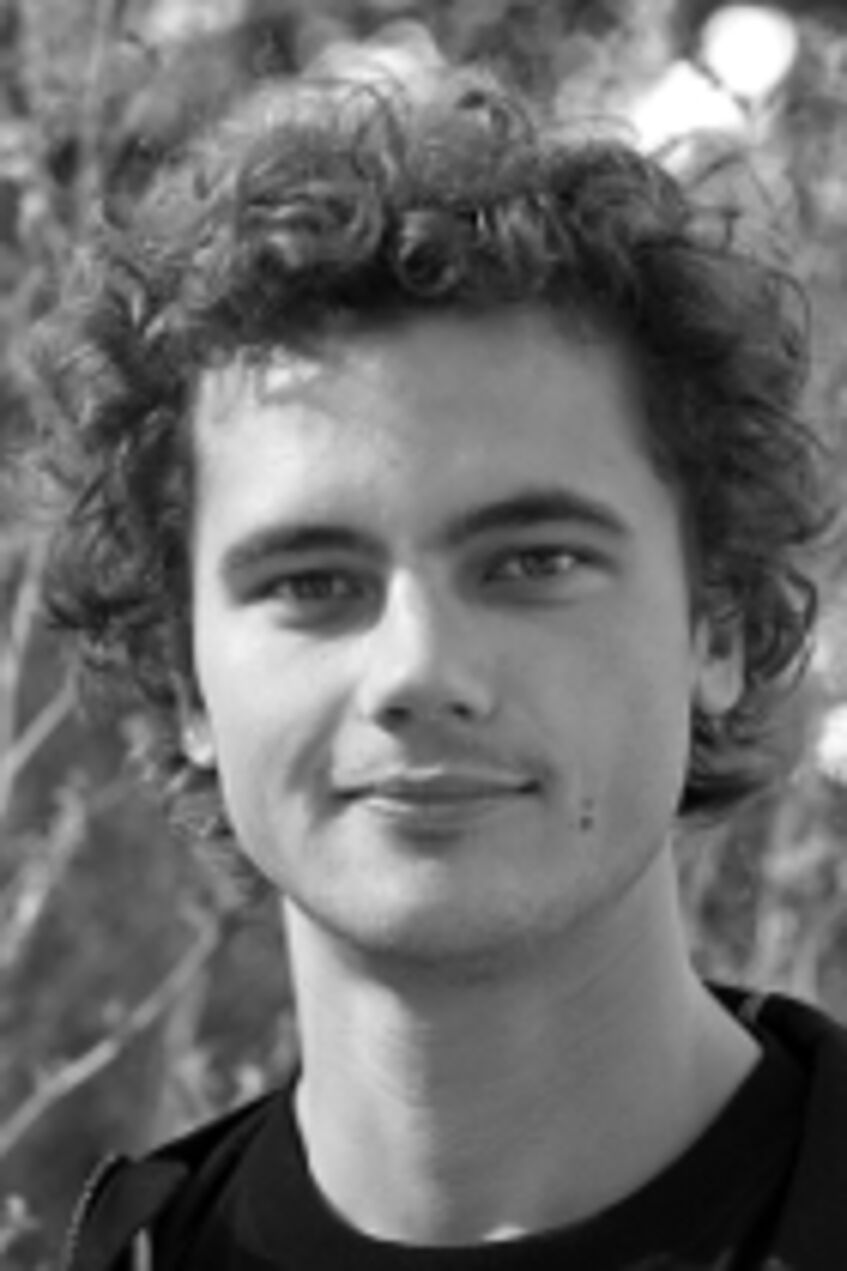Mag. Florian Etl, PhD
Wissenschaftlicher Projektmitarbeiter (Post doc)
4. Stock, Zimmer 414
t: +43 (0)1 4277-540 83
m: florian.etl@univie.ac.at

Medienbeiträge
- Science-News-Artikel:
"Plant turns suspected crop pest into pollinator" – 13. Oktober 2022 - Science ORF.at
"Blüten nutzen Parasiten als Bestäuber" - 6. Oktober 2022 - Online-Artikel im Medienportal der Universität Wien:
"Aus Feind wird Freund: Schädlinge werden zu Pflanzenbestäubern" - 6. Oktober 2022
Forschungsinteressen
- Bestäubungsbiologie
- Samenverbreitung
- Entomologie
- Tropenökologie
Curriculum Vitae
Derzeitige Anstellung
- 2024–2027 Post doc
Ausbildung und wissenschaftliche Laufbahn
- 2016–2024 Dissertant
- 2016–2020 Universitätsassistent (prae doc)
- 2011–2013 Diplomarbeit
- 2011 (Okt.) Assistent beim TBA Feldkurs Tropische Ökologie und Naturschutz, Malaysia, Borneo, Danum Valley field centre und Datenaufnahme zu Alocasia sarawakensis (Araceae)
- 2011 (Feb.) Datenaufnahme zu Dieffenbachia aurantiaca (Araceae) in Costa Rica, Tropenstation La Gamba
- 2010 (Okt.) TBA (Tropical Biology Association) Feldkurs Tropische Ökologie und Naturschutz, Malaysia, Borneo, Danum Valley field centre
- 2010–2012 Projektmitarbeiter im FWF-Projekt "Evolution und Funktionalisierung der Kesselfallen in Araceae". Untersuchungen zu Bestäubungsökologie, Thermogenese und Fruchtverbreitung von Aronstabgewächsen (Araceae) in Costa Rica and Borneo
- 2009 Nationalparkranger im Nationalpark "Neusiedlersee-Seewinkel". Erstellung und Durchführung umweltpädagogischer Projekte
- 2009–2010 Projektmitarbeiter im Forschungsprojekt "Magnetrezeption von Honigbienen" (IMP Vienna, Oxford University field station). Konditionierung von Honigbienen um zwischen verschieden starken Magnetfeldern zu unterscheiden
- 2006 Diplomstudium der Biologie (Ökologie), Universität Wien, Österreich
Publikationen
Zeige Ergebnisse 1 - 13 von 13
2025
Liu, J. W., Etl, F., Otárola, M. F., Karremans, A. P., & Ramírez, S. R. (2025). The Evolution and Ecology of Specialized Mutualisms Between Perfume Flowers and Male Euglossine Bees. Annual Review of Ecology, Evolution, and Systematics, 56, 241-264. https://doi.org/10.1146/annurev-ecolsys-102723-064710
2022
Etl, F., Kaiser, C., Reiser, O., Schubert, M., Dötterl, S., & Schönenberger, J. (2022). Evidence for the recruitment of florivorous plant bugs as pollinators. Current Biology, 32(21), 4688-4698.E6. https://doi.org/10.1016/j.cub.2022.09.013
Etl, F., Francke, W., Schönenberger, J., & Dötterl, S. (2022). Chemical Attraction of Gall Midge Pollinators (Cecidomyiidae: Cecidomyiinae) to Anthurium acutangulum (Araceae). Journal of Chemical Ecology, 48, 263-269. https://doi.org/10.1007/s10886-022-01349-3
2021
Asenbaum, J., Schäffler, I., Etl, F., Dötterl, S., Schönenberger, J., & Chartier, M. (2021). Comparative Pollination Ecology of Five European Euphorbia Species. International Journal of Plant Sciences, 182(9), 763-777. https://doi.org/10.1086/715759
Brandt, K., Dötterl, S., Ramírez, S. R., Etl, F., Machado, I. C., Navarro, D. M. D. A. F., Dobler, D., Reiser, O., Ayasse, M., & Milet-Pinheiro, P. (2021). Unraveling the Olfactory Biases of Male Euglossine Bees: Species-Specific Antennal Responses and Their Evolutionary Significance for Perfume Flowers. Frontiers in Ecology and Evolution, 9, Artikel 727471. https://doi.org/10.3389/fevo.2021.727471
Stamm, P., Etl, F., Maia, A. C. D., Dötterl, S., & Schulz, S. (2021). Synthesis, Absolute Configurations, and Biological Activities of Floral Scent Compounds from Night-Blooming Araceae. The Journal of Organic Chemistry, 86(7), 5245-5254. https://doi.org/10.1021/acs.joc.1c00145
2019
Maia, A. C. D., Grimm, C., Schubert, M., Etl, F., Gonçalves, E. G., Do Amaral Ferraz Navarro, D. M., Schulz, S., & Dötterl, S. (2019). Novel Floral Scent Compounds from Night-Blooming Araceae Pollinated by Cyclocephaline Scarabs (Melolonthidae, Cyclocephalini). Journal of Chemical Ecology, 45(2), 204-213. https://doi.org/10.1007/s10886-018-1018-1
Maia, A. C. D., Grimm, C., Schubert, M., Etl, F., Gonçalves, E. G., Do Amaral Ferraz Navarro, D. M., Schulz, S., & Dötterl, S. (2019). Correction to: Novel Floral Scent Compounds from Night-Blooming Araceae Pollinated by Cyclocephaline Scarabs (Melolonthidae, Cyclocephalini). Journal of Chemical Ecology, 45(2), 214-215. https://doi.org/10.1007/s10886-018-1026-1
Etl, F., Brandauer, S. S., Brandauer, P., Prader, S., Neier, V., Dötterl, S., & Schönenberger, J. (2019). Flower visitors of Calathea lutea (Marantaceae): The role of the hummingbird Threnetes ruckeri. Acta ZooBot Austria , 156, 183-196.
2018
Junker, R. R., Kuppler, J., Amo, L., Blande, J. D., Borges, R. M., van Dam, N. M., Dicke, M., Doetterl, S., Ehlers, B. K., Etl, F., Gershenzon, J., Glinwood, R., Gols, R., Groot, A. T., Heil, M., Hoffmeister, M., Holopainen, J. K., Jarau, S., John, L., ... Koellner, T. G. (2018). Covariation and phenotypic integration in chemical communication displays: biosynthetic constraints and eco-evolutionary implications. New Phytologist, 220(3), 739-749. https://doi.org/10.1111/nph.14505
2017
Etl, F., Franschitz, A., Aguiar, A. J. C., Schönenberger, J., & Dötterl, S. (2017). A perfume-collecting male oil bee? Evidences of a novel pollination system involving Anthurium acutifolium (Araceae) and Paratetrapedia chocoensis (Apidae, Tapinotaspidini). Flora: Morphology, Distribution, Functional Ecology of Plants, 232, 7-15. https://doi.org/10.1016/j.flora.2017.02.020
Etl, F., Franschitz, A., Aguiar, A. J. C., Dötterl, S., & Schönenberger, J. (2017). Perfume-collecting male oil bees? Evidence for a novel pollination system involving Anthurium acutifolium (Araceae) and Paratetrapedia chocoensis (Apidae, Tapinotaspidini). in XIX IBC 2017, Abstract Book I: Oral Presentations (S. 248-249). Artikel T2-55-06
2016
Etl, F., Berger, A., Weber, A., Schönenberger, J., & Dötterl, S. (2016). Nocturnal plant bugs use cis-jasmone to locate inflorescences of an Araceae as feeding and mating site. Journal of Chemical Ecology, 42(4), 300–304. https://doi.org/10.1007/s10886-016-0688-9
Zeige Ergebnisse 1 - 13 von 13
Etl, F. (2013). Reproduktionsökologie tropischer Aronstabgewächse (Araceae) am Beispiel von Dieffenbachia aurantiaca (Costa Rica) und Alocasia sarawakensis (Borneo). Diplomarbeit. Universität Wien, Wien.
